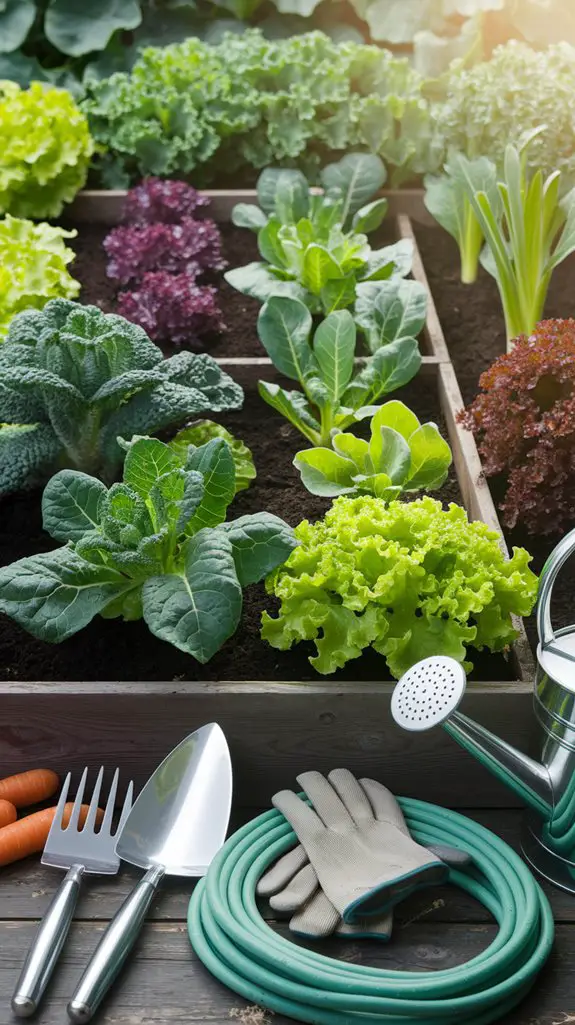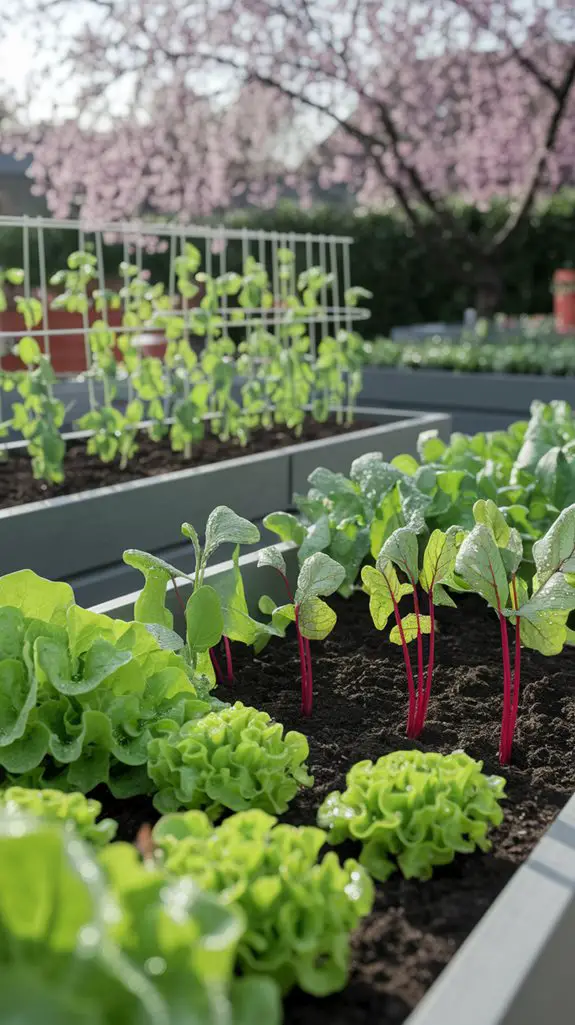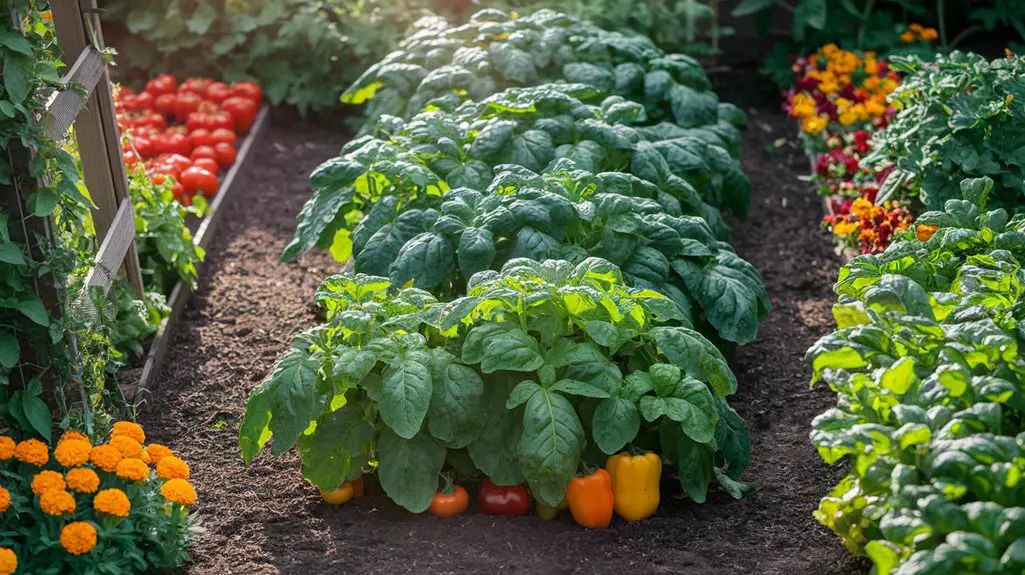You’re about to discover how growing seasonal vegetables can transform your backyard into a productive food source. By following nature’s calendar and working with your local climate, you’ll harvest fresh produce throughout the year while saving money on groceries. Whether you’re a novice or experienced gardener, understanding which vegetables thrive in each season makes all the difference. The journey begins with determining your growing zone—the foundation for your entire planting schedule.
Assessing Your Growing Zone and Seasonal Calendar
Before you plant your first seed, understanding your specific growing zone and seasonal planting calendar is essential for successful vegetable gardening. The USDA Plant Hardiness Zone Map divides North America into 13 zones based on average annual minimum temperatures, providing an important framework for your garden planning.
To determine your zone, visit the USDA website or local extension office. Once identified, create a customized planting calendar that accounts for your region’s first and last frost dates. These dates serve as boundaries for cool-season crops (lettuce, spinach, peas) and warm-season vegetables (tomatoes, peppers, squash).
Track your garden’s microclimate by noting sun exposure, wind patterns, and soil temperature. You’ll often discover pockets where certain vegetables thrive despite general zone recommendations. Additionally, starting with top vegetables to grow in your first backyard garden can enhance your gardening experience and yield.
This personalized assessment maximizes your growing season’s potential.
Essential Tools and Materials for Backyard Vegetable Gardens

Now that you’ve mapped your growing zone, it’s time to assemble the proper tools and materials that will transform your garden plans into reality.
Start with quality hand tools: a sturdy trowel, garden fork, pruners, and a hoe for weeding. You’ll need a reliable watering system—consider soaker hoses or drip irrigation for efficiency.
For soil preparation, invest in a well-balanced compost, organic fertilizer, and mulch to retain moisture.
Don’t overlook containers if space is limited; raised beds offer excellent drainage and soil control. Keep seeds organized in a waterproof container, and purchase sturdy plant markers to track your crops.
Protection materials like row covers, stakes, and cages support plant growth and deter pests.
Finally, acquire durable gardening gloves and a wide-brimmed hat for your comfort and safety.
Spring Planting: Cool-Weather Vegetables for Early Harvests

As winter’s grip begins to loosen, cool-weather vegetables offer the first opportunity to get your hands in the soil and launch your growing season.
Once soil temperatures reach 40°F, you can sow leafy greens like spinach, kale, and lettuce, which thrive in cooler conditions and tolerate light frost.
Plant peas and radishes as soon as the ground can be worked; they’ll mature rapidly in the mild spring temperatures.
Start broccoli, cauliflower, and cabbage indoors 6-8 weeks before your last frost date, then transplant when seedlings are sturdy.
Don’t overlook root vegetables—carrots, turnips, and beets can be direct-sown when soil reaches 45°F.
These cool-season crops prefer shorter days and will bolt in summer heat, so timing is essential for ideal harvests.
Summer Garden Management: Heat-Loving Crops and Maintenance
When summer’s heat fully arrives, it’s time to shift your garden focus to heat-loving crops that thrive in temperatures between 75-95°F.
Tomatoes, peppers, eggplants, okra, and melons will flourish now, requiring consistent watering and occasional shade during extreme heat periods. Use drip irrigation to deliver water directly to plant roots while minimizing evaporation and fungal issues.
Maintain your summer garden with these essential practices:
- Mulch heavily (2-3 inches) around plants to retain moisture, suppress weeds, and moderate soil temperature fluctuations
- Monitor for pests daily—squash bugs, hornworms, and aphids multiply rapidly in summer heat
- Harvest frequently, especially zucchini and cucumbers, to encourage continued production and prevent oversized, bitter fruits
Additionally, consider planting companion plants to enhance growth and deter pests effectively.
Remember to water deeply but infrequently to encourage strong root development and drought resistance.
Fall Produce: Extending Your Growing Season Into Cooler Months
The crisp autumn air signals an ideal time to shift your garden from summer’s bounty to fall’s hearty offerings.
Plant cool-weather crops like kale, spinach, Brussels sprouts, and Swiss chard that thrive as temperatures drop. Start seeds 8-10 weeks before your first expected frost for maximum growth.
Extend your growing season with simple protection methods. Cover crops with floating row covers or cold frames when overnight temperatures dip below 40°F.
Consider using mulch around root vegetables to insulate soil and prevent freezing.
Don’t forget root vegetables like carrots, beets, and turnips—they’ll sweeten after light frosts. Incorporating edible landscaping techniques can enhance your garden’s aesthetic while providing delicious harvests.
Plant garlic in mid-fall for harvest next summer.
Water less frequently but deeply as evaporation slows and monitor weather forecasts to protect plants from unexpected freezes.
Winter Preparation and Planning for Next Year’s Vegetable Garden
Winter gardening success begins with thorough preparation during the dormant season. While your garden rests, you’ll need to analyze last season’s performance, clean your tools, and map out next year’s planting schedule.
- Test your soil pH and nutrient levels now to determine what amendments you’ll need to incorporate before spring planting.
- Review your garden journal to identify which varieties thrived and which struggled, adjusting your seed orders accordingly.
- Create detailed crop rotation plans to minimize pest cycles and maximize soil fertility for the coming year.
Don’t forget to clean and sharpen your tools before storing them in a dry place.
You’ll also want to inventory remaining seeds, noting their viability dates and organizing them by planting time for efficient spring sowing. Additionally, consider incorporating seasonal vegetable varieties that are well-suited for your climate to enhance your garden’s productivity.
Conclusion
By rotating crops with the seasons, you’ll create a non-stop harvest that keeps your kitchen stocked year-round. Remember, successful vegetable gardening isn’t a sprint but a marathon that rewards consistent attention. Make notes about what thrived and what struggled, adjust your plans accordingly, and you’ll find each passing season brings greater yields and deeper satisfaction. Your backyard garden isn’t just growing vegetables—it’s cultivating self-sufficiency.




